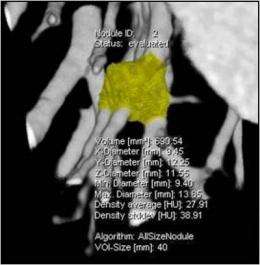New tool for clinicians proves effective predictor of lung cancer risk

A lung cancer risk prediction model developed by scientists at the University of Liverpool has been shown to be a viable tool for selecting high risk individuals for prevention and control programmes.
The model, developed at the University's Cancer Research Centre and funded by the Roy Castle Lung Cancer Foundation, was tested in international datasets and found to be a more effective predictor of individuals at risk than smoking duration or family history alone. The results are published in the Annals of Internal Medicine.
Professor John Field, who led the development of the model, said: "Risk prediction models are now considered an important method of identifying high risk patients for cancer screening programmes. Lung cancer kills more people than any other malignancy in the UK, with over 35,000 deaths per year, thus it's imperative that we have a method of identifying individuals with a high risk of developing this disease and investigate appropriately."
The risk model is now being used to select individuals for the UK Lung Cancer CT Screening Trial (UKLS), funded by the National Institute for Health Research Health Technology Assessment Programme (NIHR HTA), which is also run from Liverpool.
The Liverpool Lung Project risk prediction model calculates an individual's chance of developing lung cancer within the next five years. The model currently uses information on smoking duration; previous diagnosis of pneumonia; previous diagnosis of other cancer; occupational exposure to asbestos and relative age at onset of lung cancer diagnosis. The model is also useful for selecting high risk individuals for prevention and control programmes.
The model was validated in three independent studies from Europe and a Harvard case-control study in North America. The analysis demonstrated the model's predicted benefit for stratifying patients for CT screening. The analysis, which incorporated the harms and benefit of using a risk model to make clinical decisions, indicated that the LLP risk model performed better than smoking duration or family history alone in stratifying high-risk patients for lung cancer CT screening.
Professor Field added: "The identification of individuals with a high risk of developing lung cancer who require appropriate investigations and subsequent treatment is the most important area of early lung cancer research today. The potential for lung cancer screening programmes is now a major focus of ongoing UK and international clinical screening trials which potentially could be instigated in Europe within the next three years. We need to be in a position to have validated methods in place to identify individuals for these screening programmes. The validation of the LLP Risk Model now provides the community with a powerful tool for the selection of future patients into such screening programmes."
Paula Chadwick, Chief Executive of the Roy Castle Lung Cancer Foundation, said: "For the majority, lung cancer is characterised by late diagnosis and remains a devastating disease. That is why the Foundation has focused on funding early detection research over many years. We warmly welcome this research publication, in furthering knowledge on lung cancer screening and we thank our supporters, whose generosity has funded this important work."
















